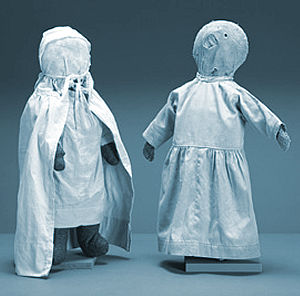
Dolls from the Thomas and Marsha French Collection
Made by Loving Hands: Amish Children's Clothing, Toys and Quilts, an exhibition of Amish objects from the Thomas and Marsha French Collection, is on display at the Ohio Arts Council's Riffe Gallery through July 8. Organized by The Kent State University Museum, the exhibition provides a glimpse into the world of Amish children. On May 6, Dr. Wayne Weaver, a practicing physician in Millersburg, Ohio and author of Dust Between My Toes: an Amish Boy's Journey, will discuss Amish customs and traditions. Family Day on May 20, 2-4 p.m. will offer activities for kids and families, including traditional Amish crafts and Amish food. For more information call 614/644-9624.
WORKFORCE
(CONT'D. from
Page 1)
physical weight of our nation's economic output is the same. This is because our economy has shifted from one that produces and manufactures goods to a new economy focused on ideas, services and technologies.
As unemployment continues to remain near record lows, many states cannot provide enough workers to satisfy some industries. Technology companies, unable to fill staffing needs with U.S. workers alone, are pressuring Congress to raise the number of six-year visas for technology workers from 115,000 to 200,000 a year to meet their demand. So, as businesses consider their future, finding states with education systems that can produce skilled workers to meet their employment needs will become even more important.
Businesses believe that the arts are an important component in building a well-educated workforce. According to a national survey, 58 percent of businesses (and 76 percent of large businesses) say that arts support is essential to educating children in their communities. It is well documented that including the arts in education increases student achievement and skills in other areas.
In one study, reading comprehension was shown to improve when children took drama classes in addition to their regular classes. In a study that included multiple cities, high-risk children placed in an arts program consistently scored higher in core subjects than children not placed in the program.
With a combination of public and private support for arts educators, states can build a workforce that will help fill the needs of businesses and make their communities more competitive in the new economy.
Courtesy of National Assembly of State Arts Agencies
![]()
The National Endowment for the Arts and the U.S. Department of Housing and Urban Development are jointly awarding $2.7 million to community schools for the arts to provide arts instruction for youth living in public housing. The new program, called Creative Communities, will make available free, weekly arts instruction by professional artists at 20 sites in 20 different states. Cleveland Public Theatre is one of those sites. The award will support Brick City Theatre, a program of sequential theater arts instruction for children and youth residing in public housing developments of the Cuyahoga Metropolitan Housing Authority. For more information on Creative Communities call 202/682-5570.